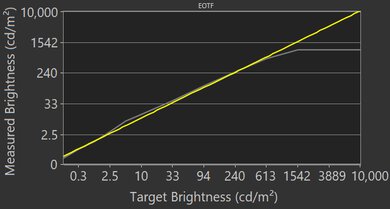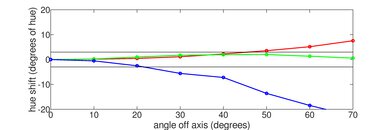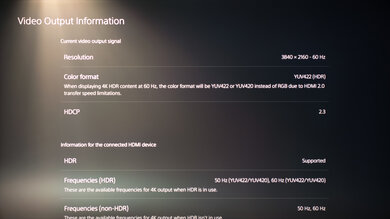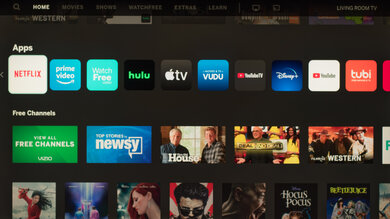The Vizio P Series Quantum 2020 is an overall great 4k TV. Like its predecessor, the Vizio P Series Quantum 2019, it sports a VA panel that can display deep blacks, and it has a full-array local dimming to improve black level further, making it a great choice for dark room viewing. It's also well-suited for bright rooms thanks to its high peak brightness and good reflection handling. It has a fast response time, an optional Black Frame Insertion feature, and can interpolate lower frame rate content up to 120 fps for fans of the soap opera effect. Its input lag is very low and supports variable refresh rate technology to reduce screen tearing when gaming. Unfortunately, its narrow viewing angles make it less ideal for large rooms and wide seating areas, as the image looks washed out from the sides. Also, its local dimming causes blooming around bright objects, which can be distracting. On the upside, it delivers a great HDR experience, as it has an excellent color gamut and gets bright enough to make highlights stand out.
Our Verdict
The Vizio P Series Quantum 2020 is an overall great TV. It has a high contrast ratio that allows it to produce deep blacks, making it great for watching movies in the dark. It has an excellent HDR color gamut, a full-array local dimming feature, and gets very bright to deliver a great HDR experience. Its fast response time results in minimal motion blur in fast-moving scenes and, combined with its low input lag, it's well-suited for playing video games. Unfortunately, it has poor viewing angles, and its local dimming causes a lot of blooming.
- High contrast ratio.
- Gets very bright.
- Good reflection handling.
- Poor viewing angles.
- Some vignetting and dirty screen effect.
The Vizio P Series Quantum 2020 is great for watching movies. It delivers good picture quality thanks to its high contrast ratio, but its full-array local dimming causes a lot of blooming, and there's clouding throughout the screen on our unit, which can be distracting. On the upside, it upscales lower resolution movies well, and it can remove judder from 24p sources and native apps.
- High contrast ratio.
- Can remove judder from 24p sources and native apps.
- Blooming around bright objects and subtitles.
- Some vignetting and dirty screen effect.
The Vizio P Series Quantum 2020 is good for watching TV shows. It handles reflections well, and it gets bright enough to fight glare, so you shouldn't have any issues with visibility in broad daylight. However, its VA panel's poor viewing angles cause images to look washed out when viewed from the side, making it less ideal for those who like to walk around while watching TV.
- Gets very bright.
- Good reflection handling.
- Poor viewing angles.
- Some vignetting and dirty screen effect.
The Vizio P Series Quantum 2020 is good for watching sports. It has a fast response time that results in minimal motion blur and a Black Frame Insertion feature to improve clarity further. It handles reflections well, and it gets bright enough to overcome glare in well-lit environments. The viewing angles are poor, though, which isn't ideal for watching a big game with a large group of people.
- Gets very bright.
- Fast response time.
- Good reflection handling.
- Poor viewing angles.
- Some vignetting and dirty screen effect.
The Vizio P Series Quantum 2020 is excellent for gaming. Its fast response time and 120Hz refresh rate make fast-moving scenes look crisp and buttery smooth. It has incredibly low input lag to make every action feel almost instantaneous, and it supports variable refresh rate technology to deliver a nearly tear-free gaming experience. Its VA panel can produce deep blacks, making it a good option for gaming in the dark.
- High contrast ratio.
- Low input lag.
- Fast response time.
- VRR doesn't work.
The Vizio P Series Quantum 2020 is great for watching movies in HDR. It has a high contrast ratio to produce deep blacks, an excellent color gamut, and a high peak brightness to make highlights pop. However, black uniformity isn't that good on our unit, and the local dimming feature causes a lot of blooming around bright objects.
- High contrast ratio.
- Gets very bright.
- Can remove judder from 24p sources and native apps.
- Excellent HDR color gamut.
- Blooming around bright objects and subtitles.
- Some vignetting and dirty screen effect.
The Vizio P Series Quantum is excellent for gaming in HDR. It has excellent motion handling due to its fast response time and 120Hz refresh rate. Its input lag is low and remains low when playing in 4k with 10-bit HDR. Also, it supports variable refresh rate technology to reduce screen tearing. It can deliver a stunning HDR experience, as it has an excellent color gamut to produce vibrant colors and a high peak brightness to make highlights pop.
- High contrast ratio.
- Gets very bright.
- Low input lag.
- Fast response time.
- Excellent HDR color gamut.
- Blooming around bright objects and subtitles.
- VRR doesn't work.
The Vizio P Series Quantum 2020 is a great TV for use as a PC monitor. It has low input lag, a fast response time, and supports most common resolutions. It has excellent reflection handling and gets very bright to provide good visibility in well-lit environments. Unfortunately, its poor viewing angles make images look washed out at the edges if you sit close to the screen. Also, while it supports chroma 4:4:4, it's a little buggy right now and would require a firmware update.
- Low input lag.
- Fast response time.
- Good reflection handling.
- Poor viewing angles.
Changelog
- Updated Sep 26, 2025: We uploaded the latest brightness measurements and uniformity photos for the Accelerated Longevity Test.
- Updated Jul 08, 2025: We uploaded the latest brightness measurements and uniformity photos for the Accelerated Longevity Test.
- Updated Apr 17, 2025: We uploaded the latest brightness measurements and uniformity photos for the Accelerated Longevity Test.
- Updated Feb 11, 2025: We uploaded the latest brightness measurements and uniformity photos for the Accelerated Longevity Test.
Check Price
Differences Between Sizes And Variants
We tested the 65" Vizio P Series Quantum 2020 (P65Q9-H1), and for the most part, we expect our results to be valid for the 75" (P75Q9-H1) model as well, though the different amount of dimming zones will affect local dimming performance slightly.
| Size | Model | Dimming Zones |
|---|---|---|
| 65" | P65Q9-H1 | 200 |
| 75" | P75Q9-H1 | 240 |
If someone comes across a different type of panel or their P Series Quantum doesn't correspond to our review, let us know and we'll update the review. Note that some tests, like gray uniformity, may vary between individual units.
The manufacturing date of our unit isn't indicated; you can see the label here.
Popular TV Comparisons
The Vizio P Series Quantum 2020 is an overall good 4k TV. There are a few minor improvements over its predecessor, the Vizio P Series Quantum 2019, but there are also better TVs that cost less, like the Hisense H9G.
For more options, check out our recommendations for the best TVs, the best 4k TVs, and the best 4k gaming TVs.
The Vizio P Series Quantum X 2020 is better than the Vizio P Series Quantum 2020. The X 2020 has better local dimming, slightly better reflection handling, and gets much brighter. The P Series Quantum 2020 has faster response time, though, and it also has better color accuracy out of the box.
Overall, the Hisense H9G is much better than the Vizio P Series Quantum 2020. The Hisense has a higher contrast ratio, its local dimming performs better, and it gets brighter in SDR and HDR. It also has a faster response time, and it's cheaper. However, the Vizio has better color accuracy out of the box, a much better HDR color gamut, and lower input lag.
The Vizio P Series Quantum 2020 and the Sony X900H are very similarly performing TVs. The Vizio has a higher contrast ratio, better color gamut, and gets brighter. However, the Sony has a better local dimming feature and better color accuracy. It also has more apps available due to the Google Play Store, and it can remove judder from all sources.
For most uses, the Vizio P Series Quantum 2020 is better than the Samsung Q70T. The Vizio has local dimming, which the Samsung doesn't have, and it gets a lot brighter in SDR and HDR. It also has a much better HDR color gamut and faster response time. However, the Samsung has a higher contrast ratio and a lower input lag.

We buy and test dozens of TVs yearly, taking an objective, data-driven approach to deliver results you can trust. Our testing process is complex, with hundreds of individual tests that take over a week to complete. Most of our tests are done with specially designed test patterns that mimic real content, but we also use the same sources you have at home to ensure our results match the real-world experience. We use two main tools for our testing: a Colorimetry Research CR-100 colorimeter and a CR-250 spectroradiometer.
Test Results

The Vizio P65Q9-H1 has an excellent design and looks nearly identical to its predecessor, the Vizio P Series Quantum 2019. It's simple and clean, with thin borders on all sides.
Update 07/08/2025: The number of dead LEDs has increased significantly since the last longevity update.
Update 04/17/2025: Multiple dark spots have appeared over the last few months, mostly near the bottom edge of the screen. This TV has a full-array backlight, meaning the LEDs are placed directly behind the screen, so these dark spots are likely failed LEDs in the backlight. The overall brightness of the screen hasn't decreased that much since the beginning, but these failures appeared suddenly, so the entire backlight may be starting to fail.
The back is nearly identical to the Vizio P Series Quantum 2019. It's a lightly textured plastic, and there's no cable management.
Update 11/03/2021: We retested the contrast with local dimming on 'Medium' instead of 'High'. Contrast is much better with the 'Medium' and 'Low' settings:
- High: 6089:1
- Medium: 11610:1
- Low: 11840:1
The Vizio P65Q9-H1 has an outstanding contrast ratio and can produce deep blacks. It's better with local dimming enabled, but not by much. Note that the contrast ratio can vary between units.
Update 02/15/2021: We updated the TV to the latest firmware and retested the SDR peak brightness. The 2% and 10% sustained windows became more dim, while the 25%, 50%, and 100% windows got brighter. The review has been updated.
Excellent SDR peak brightness. It varies a lot depending on the scene, but overall, it's enough to overcome glare in a bright environment.
We measured the SDR peak brightness after calibration, using the 'Calibrated Dark' Picture Mode, with Backlight at max, Active Full-Array set to 'High', Gamma set to 2.2, and Color Temperature set to 'Warm'.
If you don't mind losing a bit of image accuracy, you can get a brighter picture using the 'Vivid' Picture Mode, with Backlight at max, Active Full-Array set to 'High', Gamma set to 2.2, and Color Temperature set to 'Cool'. We achieved a peak brightness of 1101 cd/m² in the 10% window using these settings.
Update 07/28/2021: Added the real content local dimming videos.
Update 12/16/2020: We've retested the local dimming with the latest firmware version 5.10.15.5-4. Not much has changed, but like the Vizio P Series Quantum X 2020, we now recommend using the 'Medium' setting as it causes less blooming than the 'High' setting.
The Vizio P Series Quantum has a decent full-array local dimming feature. It performs zone transitions relatively well, as it can follow slow-moving objects pretty closely, but it lags when there's faster movement. While zone transitions are visible when playing our test pattern, it isn't as bad in regular content.
There's a fair amount of blooming, more so in regular content than with our test pattern. It tends to make dark areas look grayish or over-brighten dark spots that have some form of light. It isn't always noticeable, but it can be distracting. Blooming isn't uniform, as some areas bloom more intensely than others. Unfortunately, subtitles aren't handled well. They're very bright, and there's a lot of blooming around them.
Even though the circle in our test pattern dims a lot when it's moving around quickly, it doesn't seem to be an issue in regular content. Unlike the Vizio P Series Quantum 2019, we find almost no difference between the 'Medium and the 'High' setting (local dimming is called Active Full-Array in the settings). We recommend using the 'Medium' setting.
On the 'High' setting, small highlights like stars look okay and aren't crushed. That said, there's blooming, and it doesn't happen on every star, which makes the screen look blotchy.
Update 07/28/2021: Added the real content local dimming videos.
The local dimming in Game Mode is decent and looks the same as outside of Game Mode.
Update 02/15/2021: We updated the TV to the latest firmware and retested the HDR peak brightness. The 2% and 10% sustained windows became more dim, while the 25%, 50%, and 100% windows got brighter. The review has been updated.
Great HDR peak brightness. Like in SDR, there's a lot of brightness variability when displaying different content. It can get very bright, enough to deliver a good HDR experience. The successor to this TV, the Vizio P Series Quantum 2021, gets even brighter in HDR.
We measured the HDR peak brightness before calibration, using the 'Calibrated Dark' Picture Mode, with Backlight at max, Active Full-Array set to 'High', Gamma set to '2.2', and Color Temperature set to 'Warm'.
If you don't mind losing image accuracy, set the Picture Mode to 'Vivid', with Active Full-Array set to 'High', and Color Temperature set to 'Cool'. We achieved a peak brightness of 1090 cd/m² in the 10% window using these settings.
Update 09/30/2020: After warming up the TV for three hours to remeasure input lag, the backlight became visible, and we noticed uniformity issues. You can see the photo here, but note that this is taken on a phone and not our usual camera setup. If you have this TV and notice this issue, let us know.
Gray uniformity on our unit of the Vizio P Series Quantum is okay. The corners and edges are darker, and there's visible dirty screen effect in the center. Uniformity is better in dark scenes, but still not that great, especially on the left side of the screen. Note that gray uniformity can vary between units.
Update 01/08/2021: We reuploaded the black uniformity photos because there was an issue with the original photos. This improved the results, and the review has been updated.
The black uniformity is great. There's a bit of clouding without local dimming, and it's noticeable in the corners. However, with local dimming, there's no clouding and only a bit of blooming around the center cross. Note that black uniformity may vary between units.
Like most VA panel TVs, the Vizio P65Q9-H1 has poor viewing angles, which isn't ideal for large rooms or wide seating areas. There's an Enhanced Viewing Angle feature that can help improve viewing angles slightly, but it causes spatial dithering.
Update 10/14/2020: We've retested the reflection handling and determined that the performance is more in-line with the Vizio P Series Quantum X 2020's. The score has been updated accordingly.
Excellent reflection handling. It handles ambient light well and even though it may not be the best choice to place it opposite a window, it still performs well in bright rooms.
Out-of-the-box, the Vizio P65Q9-H1 has good color accuracy. Most color inaccuracies are relatively minor, but white balance is off, and the color temperature is on the warm side, resulting in a slight reddish tint. Gamma follows the target reasonably well; however, both dark and bright scenes are over-brightened. Note that color accuracy can vary between units.
After calibration, the color accuracy is exceptional. White balance and gamma are nearly perfect, and the remaining color inaccuracies shouldn't be noticeable. The color temperature is much closer to our 6500K target.
You can see our recommended setting here.
Update 10/26/2020: We've retested the Enhanced Viewing Angle feature. It now works but it causes dithering, as you can see in this photo.
4k content is displayed perfectly.
This TV uses a BGR sub-pixel structure and may affect text clarity when using it as a PC monitor. You can read more about it here.
The Vizio P65Q9-H1 has an excellent HDR color gamut. It has near full coverage of the commonly-used DCI P3 color space and great coverage of the wider Rec. 2020. The EOTF follows the PQ curve almost perfectly until the roll-off, and the 'Game' mode EOTF is nearly identical. If you find HDR content too dim, you can get a brighter image by setting the Picture Mode to 'Calibrated Dark', Active Full-Array to 'High', Gamma to '1.8', Backlight to max, and Local Contrast to 'Medium'. These settings result in a much brighter image, as you can see in this EOTF.
We don't expect VA panels to experience permanent image retention, as the VA panel in our long-term test appears immune.
The Vizio P65Q9-H1 has an optional Black Frame Insertion (BFI) feature to improve motion clarity. Enabling it lowers the backlight's flickering frequency to 60Hz. Unfortunately, there's terrible strobe crosstalk, resulting in image duplication. To use BFI, turn on Clear Action.
This TV can interpolate lower frame rate content up to 120fps to make motion look smoother, otherwise known as the 'Soap Opera Effect'. It does a pretty good job in quiet to moderately fast-moving scenes, but there are artifacts if the action gets too intense. To interpolate 30fps content, increase Judder Reduction, and for 60fps content, increase Blur Reduction. These settings need to be adjusted depending on the content that you're watching.
Due to the TV's fast response time, lower frame rate content can appear to stutter, since each frame is held for longer. If stutter bothers you, enabling motion interpolation can help.
This TV can remove judder from 24p sources and native apps, but not from 60p or 60i sources. To remove judder, enable Film Mode. Unlike the Vizio P Series Quantum 2019, setting Judder Reduction to '1' doesn't remove judder from 60p/60i sources.
Update 10/26/2020: We've retested the VRR with the new firmware (version 5.10.13.1-2). It only works at 4k @ 60Hz, but the VRR range is smaller, from 48-60Hz. At 4k 120Hz, the screen is still tearing a lot when VRR is enabled. Also, VRR doesn't work at 1440p @ 60Hz, and at 1440p @ 120Hz, enabling VRR causes visible artifacts. It can detect G-SYNC on an NVIDIA RTX 3080 graphics card, but turning on VRR causes a crash and requires resetting the PC.
The Vizio P65Q9-H1 is advertised to have HDMI Forum VRR support. However, it doesn't seem to be working at this time, even though our connected Xbox indicates that it's functioning correctly. It also caused a few crashes when enabled. We suspect that this is a bug that'll likely be fixed in a future firmware update. To turn on VRR, set Game Low Latency and Variable Refresh Rate to 'On'.
Update 10/26/2020: We've retested the input lag with the latest firmware (version 5.10.13.1-2) and an HDMI 2.1 source. The 4k with VRR input is measured at 60Hz since VRR doesn't work at 4k @ 120Hz.
Update 09/30/2020: Remeasured the input lag at 1080p @ 60Hz because it was much lower compared to 2019 Vizio TVs and the Vizio P Series Quantum X 2020. The input lag only slightly increased, and the review has been updated.
The Vizio P65Q9-H1 has excellent low input lag, a nice improvement from the Vizio P Series Quantum 2019. Motion interpolation is usable when gaming; however, it adds significant input lag and isn't recommended.
To get the lowest input lag, set Game Low Latency to 'On'. You can also set it to 'Auto' if you want to enable the 'Auto Low Latency Mode', which turns the mode on automatically when the TV detects a game launching from a compatible device. For signals that require full bandwidth, Vizio removed the Full UHD Color settings, so there's nothing to change.
For PC use, set Game Low Latency to 'On'. Vizio has removed the 'Computer' mode.
Note: We encountered a few issues while testing the input lag. The first is that the TV skips frames when playing 1080p or 1440p content at 120Hz with Game Low Latency on. The second is that the input lag results are very inconsistent at 120Hz, as they vary wildly between each run. Testing was done on multiple computers, and we couldn't get consistent results on any of them. We suspect that this is a bug; we'll retest it once an update is available.
Using its latest firmware, version 5.41.29.10-1, the Vizio P Series Quantum 2020 supports most common resolutions under the HDMI 2.0 bandwidth, but there are some issues with signals that require HDMI 2.1 bandwidth. It displays 4k @ 120Hz outside of Game Mode, but it skips frames with Game Low Latency enabled. It also skips frames with 1080p and 1440p signals in Game Mode, but both work without issue outside of Game Mode. For 1440p signals, you need to create a custom resolution from your PC.
For chroma 4:4:4, it displays it properly with 60Hz signals, and for 1440p @ 60Hz signals with chroma 4:4:4, you need to set your PC to 'RGB' instead of 'YCbCr444'. As for 1080p, 1440p, and 4k signals at 120Hz with chroma 4:4:4, the TV accepts the signal, but text looks blurry.
This TV supports HDMI 2.1 on ports 3 and 4, as they're the only ones that accept a 4k @ 120Hz signal. That said, the TV's 'Auto Low Latency Mode' works on all ports.
The Vizio P65Q9-H1 supports eARC, allowing it to pass high-quality audio like Dolby Atmos via TrueHD over an HDMI connection. To use it, set eARC to 'On', and Digital Audio Out to 'Auto'.
The Vizio P65Q9-H1 has an okay frequency response. It's reasonably well-balanced, and dialogue comes across clearly. Unfortunately, it lacks bass extension to produce a thumping or rumbling sound. On the bright side, it gets very loud without adding too much compression at max volume.
Decent distortion performance. There's almost no distortion at all when playing at moderate volume levels. Even at max volume, it's extremely low and shouldn't be audible.
Update 11/11/2020: The SmartCast version was incorrectly listed as version 1.60, when it's in fact version 1.40.
Vizio's SmartCast platform is decent. It's easy to use, but it's a little buggy. In addition to the issues mentioned in the input lag and supported resolution sections, the interface crashes from time to time.
There aren't any ads on the home screen, only suggested content from Vizio to promote their WatchFree feature.
Update 11/03/2021: We updated the voice control results for consistency with our other reviews. Although the remote doesn't have built-in voice control, the companion app does. With it, you can change inputs or launch specific apps, but you can't search for content or adjust settings.
The remote has changed slightly from the Vizio P Series Quantum 2019. It now has a circular navigation pad, but otherwise, it provides the same functions.




















































